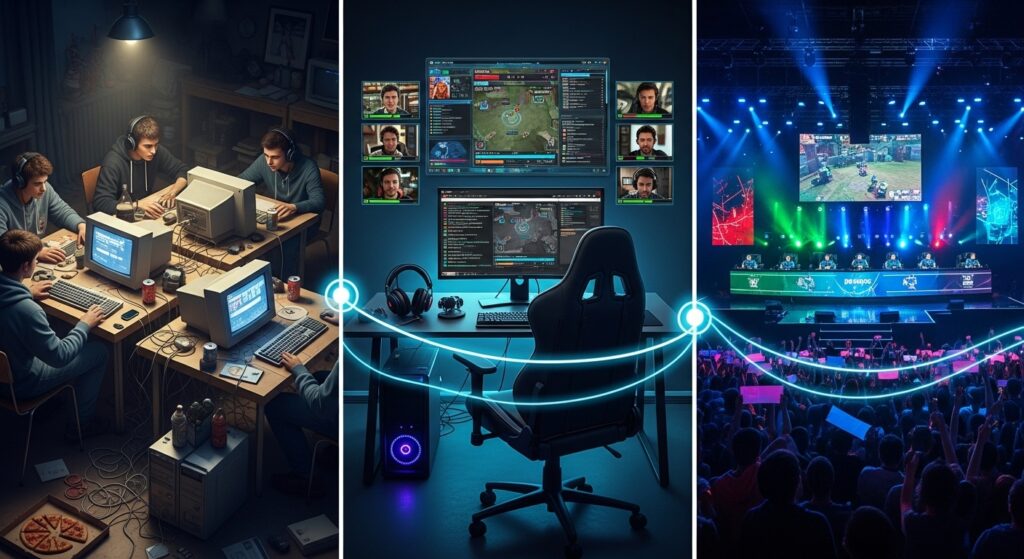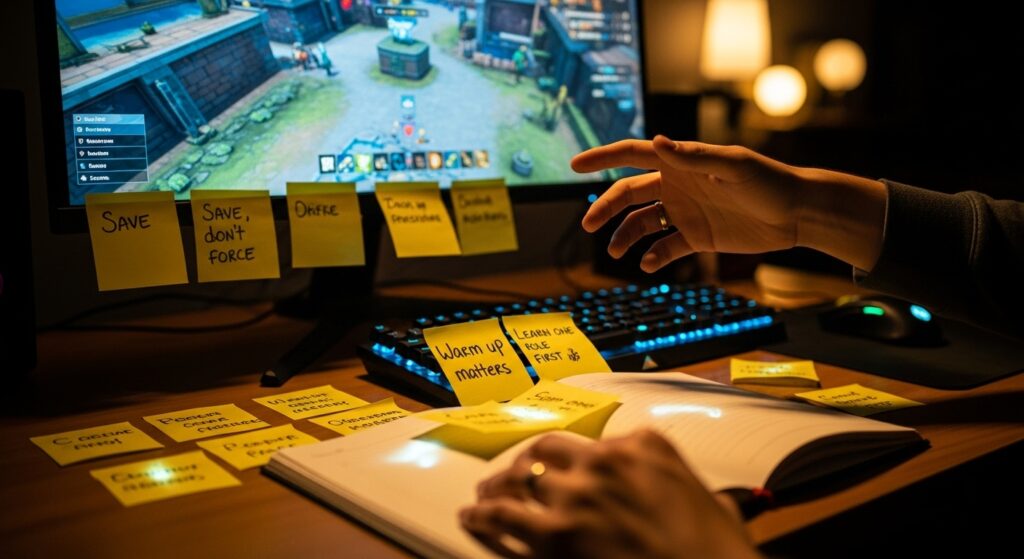Let’s talk about Esports without the pitch deck perfume. I’ve been in this thing for more than 10 years—caffeine, LAN lines, broken stage mics, all of it. And yes, I’ve been tracking Esports industry growth 2025 with way too many spreadsheets and not enough sleep. In my experience, when people say “the Esports market is exploding,” what they usually mean is they saw a hype reel with lasers.
I care more about the boring stuff: viewership, revenue, sponsorship, media rights, team budgets, prize pools, mobile Esports, and how much actual money lands in the bank. You know, the stuff you can pay rent with. If you’re looking for a simple story, sorry. It’s messy, but fun messy. Like a scrim with voice chat still on.
The Rise of Esports: A Quick, Honest Tour of the Industry’s Evolution

Years ago, someone told me esports would be “bigger than the Super Bowl.” Cute. I remember working a small regional tournament in 2014 where the prize pool was a pizza voucher and a hoodie. I slept on a beanbag. The PC crashed mid-final. We still got 500 viewers and I thought we were kings. That’s the vibe I bring to this. I love this scene, but I’m not here to sell you a fantasy.
If you want history vibes, you can start with the basics on what esports is. The short version: people play games, other people watch, brands eventually show up, and then someone tries to put it on TV and gets confused by Twitch chat. That loop, over and over, just with bigger venues and more LED panels.
2013–2015: The “We Can Do This!” Era
Back then, LAN events were janky but charming. Teams were scrappy. Prize pools felt huge at $50k. Everyone shared hotel rooms. In my notebook, I wrote “esports is actually a thing” and underlined it five times. But the business model? Basically vibes and ad reads.
2016–2019: The VC Wave and Franchising Fever
Money rolled in. New leagues. Franchising. Team valuations that made my accountant friend choke on his burrito. Media rights deals promised the sun. I saw agencies pitch “hockey-stick growth” like it was a ritual. We built big arenas, fast, and we assumed viewers would convert to buyers like magic. Spoiler: conversion math is not a fairy tale.
2020–2021: The Lockdown Bump
Everyone was home. Viewership up. New fans. New sponsors. I was doing two Zoom calls at once—one with a publisher, one with a team GM—nod-and-smile speedrun. It felt like every stream hit new highs. The problem: some folks thought 2020 numbers were the new normal. They weren’t.
2022–2024: Sober, But Smarter
Teams trimmed budgets. Leagues cut formats. People said the bubble burst. Nah. The froth popped, sure, but the base is real. I’ve always found that slow growth beats hype growth. We started caring about merch margins, ticket yields, and long-term sponsors who aren’t just “testing.” More boring meetings. Fewer wild promises. Thank goodness.
So What About 2025? The Vibe Check
What I think is: 2025 looks… steady. Not fireworks every week. But solid. You’ll see areas of sharp growth (mobile tournaments, MENA and Southeast Asia, creator-led events), and other parts that are flat or correcting (some PC titles, some overbuilt leagues). The good news for normal humans: this is the year where business models finally act like business models. Less “we’ll figure it out later.” More actual revenue streams that make sense: sponsorship, media rights, ticketing, digital goods, and publisher-backed programs that don’t set money on fire.
Viewership vs. Revenue: The Esports Growth Dilemma
You can have millions of viewers and still lose money. I’ve seen teams with massive fanbases struggle because sponsors churn or because travel costs eat the budget. On the flip side, I’ve seen small, regional circuits run a tight ship and make a profit with 5-figure audiences.
My Simple Viewership-to-Revenue Reality Table
| Scenario | Audience Size | Monetization Health | Notes |
|---|---|---|---|
| Big Hype, Thin Margins | 1M+ peak | Fragile | High event costs, weak sponsor renewals, media rights uncertain |
| Mid-Sized, Efficient | 100k–500k | Stable | Strong local sponsors, good merch, repeatable venues |
| Creator-Driven | Varies | High potential | Branded content, flexible formats, lower fixed costs |
| Publisher-Funded Circuit | Varies | Depends | Safer if subsidies persist; risky if they don’t |
Where the Money Will Come From in 2025: Key Revenue Streams
In my experience, 2025 revenue comes from a mix. Not one silver bullet. If someone says “we’ll just do media rights,” smile and back away slowly. Here’s my rough take:
Segments I Watch And Expect (Reasonable) Growth In 2025
| Revenue Stream | My 2025 Take | Why It Moves |
|---|---|---|
| Sponsorship’s | Moderate growth | Better analytics, long-term deals, category diversity |
| Media Rights | Selective growth | Platform deals in APAC/MENA; not a gold rush |
| Ticketing & Events | Up if executed lean | Smaller venues, repeatable formats, regional hubs |
| Merch & Collectibles | Steady | Collabs, limited drops, player-driven designs |
| Digital Items/Passes | Growing | Battle pass tie-ins, viewer rewards, no-NFT drama please |
| Publisher Subsidies | Mixed | Some titles invest more, others scale down |
And yes, if you need big-picture numbers, check the market snapshots on places like global esports revenue estimates. I’m a fan of using those as signposts, not gospel. Models vary, definitions vary, and not everyone counts the same stuff.
Where Esports Growth Is Hiding in 2025 (If You’re Willing to Look)

Mobile Esports: The Elephant That Fits in Your Pocket
I used to laugh at mobile tournaments. Then I went to one in Southeast Asia and watched an arena sell out faster than a K-pop pop-up. The energy is unreal. Lower hardware costs, huge player base, easy to watch on the bus. If you want volume, players, viewers, sponsors who care about mass market, mobile is your friend. India, Indonesia, Philippines, Brazil, MENA. That’s your heat map.
Regional Leagues with Local Flavor
Local partners. Local brands. Local memes. It all matters. A regional league with a proper content plan and meetups can build loyal fans way faster than a global league with no local identity. I’ve seen small arenas packed every week because the fans know the players by name and see them at the food truck after. This is not rocket science. It’s community.
Collegiate and Scholastic
I do guest talks at schools. The interest is wild. School teams, clubs, local LANs, parents now ask me about scholarships instead of “what is an esports?” This space won’t print money overnight, but it builds the funnel: talent, coaches, broadcast students, event staff. Plus, it’s actually fun and healthy when done right. Clear rules, good supervision, and yes, snacks.
Creator-Led Competitive Shows
Streamers who spin up their own tournaments? Big win. Lighter production. Built-in audience. Brands like the personality tie-in. If I had $100k to spend, I’d rather co-produce a creator cup with a series plan than sponsor a one-off mega-event I can’t repeat. Easier math. Less stress.
Betting and Fantasy (Careful, Captain)
This is a thing, and it’s growing. But do it legally, with guardrails, and partner with people who take integrity seriously. I’m not kidding. Betting without proper rules is how you end up on a scary PDF in front of a regulator. Also, protect the players. The lines between fun and harmful get thin fast.
Sustainable Business Models for Esports Growth in 2025
Lean Teams That Focus
Pick two titles. Nail your content. Lock in two to three long-term sponsors. Keep your player payroll sane. Travel smart. I’ve seen “lean teams” hit break-even faster because they aren’t chasing clout every quarter. Fans respect teams that communicate, show their grind, and stop pretending to be a fashion brand every other week.
Events as a Product, Not a Party
Reusable stage designs. Modular production. Venue partners who don’t fleece you on AV. Put the audience first: good seats, clear schedule, bathroom lines that don’t resemble a theme park. Sell weekend passes, VIP behind-the-scenes, player meet-and-greets. The extra $20 add-on matters.
Tools and Infrastructure (B2B Is Unsexy and Profitable)
Bracket tools, anti-cheat, coaching apps, production automation, sponsorship dashboards. This is where founders actually sleep at night. Sell software. Ship updates. Charge fairly. Esports needs more reliable tools than more “lifestyle brands.” Sorry, not sorry.
Data and Rights (Slow and Steady)
Aggregated, clean stats. Broadcast-friendly overlays. Regional media packages. If you build neat data layers that help fans and help talent tell stories, operators will pay you. Not a fortune. But they will.
Tech Innovations Shaping Esports Growth in 2025
Cloud Gaming and Low-Latency Streams
Not for every title, not yet. But for casual cups and school leagues? Huge. The ability to spin up games without hauling rigs changes who can host events. It lowers that “barrier to play and watch.” Keep an eye on it.
AR/VR? Maybe. Mostly AR.
VR is cool but clunky for competitive viewership. AR overlays in venues? Chef’s kiss. Stats on the jumbotron, clean player cams, live heatmaps. If it helps a new fan understand what’s going on, it has legs. If it’s just shiny, pass.
Anti-Cheat and Integrity
Cheaters kill trust. If you run a league in 2025, put budget into anti-cheat and admin staff who can act quickly. I’ve been in rooms where a late-stage DQ saved the season’s credibility. Rough day. Worth it.
Health, Sleep, and Coaching
Player burnout is real. Proper schedules, sports psych, posture checks, eye breaks—it’s not soft. It’s performance. Team managers who invest here last longer. And yes, team chefs who can do more than chicken tenders help too.
Contracts and Trust in Esports: Navigating the 2025 Landscape
I’m not your lawyer, but I read more esports contracts than is healthy. Get basics right: payment terms, revenue splits, IP rights, event insurance, cancellation clauses. If you ever want a quiet Sunday, write your own terms and conditions and actually enforce them. Sounds boring. Saves careers.
Predictions for Esports Industry Growth in 2025
- More small, profitable events. Fewer giant money pits.
- Mobile viewership beats some PC titles in key regions, again.
- One big creator league surprises everyone with real structure.
- At least two new brands enter and stick for three years. Not just “test and ghost.”
- One league pauses a season to “retool.” Everyone freaks out for a week. It’s fine.
- Merch moves from random drops to real product lines with athlete input.
- More crossover: traditional sports orgs double down on a few titles, not all.
Mini Case Notes From My Notebook
Sample Team Budget Thought Experiment (2025)
These are made-up numbers to show the shape, not a promise. But they’re close enough to spark a real talk.
| Line Item | Lean Team (2 Titles) | Bloated Team (5 Titles) |
|---|---|---|
| Player Salaries | $300k | $1.6M |
| Staff & Coaches | $180k | $600k |
| Travel & Lodging | $120k | $400k |
| Content & Production | $150k | $450k |
| Facilities & Equipment | $80k | $250k |
| Marketing | $50k | $200k |
| Misc (legal, insurance, fees) | $40k | $120k |
| Total Annual Spend | $920k | $3.62M |
| Sponsor Revenue | $700k | $2.1M |
| Merch & Digital | $120k | $300k |
| Prize Winnings (volatile) | $60k | $250k |
| Media/Platform Deals | $80k | $200k |
| Total Revenue | $960k | $2.85M |
See the issue? The lean team can flirt with break-even. The bloated team hopes to win big or raise funding, forever. In my experience, 2025 rewards lean, repeatable ops with clear stories and stable sponsors. Not sexy. But it works.
Event P&L Snapshot (Hypothetical Regional Final)
| Category | Amount | Notes |
|---|---|---|
| Sponsorship | $180k | Naming + 3 category partners |
| Ticketing | $90k | 3,000 attendees avg $30 |
| Merch & Concessions Share | $25k | Split with venue |
| Media/Platform | $30k | Regional stream partner |
| Total Revenue | $325k | |
| Venue & AV | $110k | Negotiate the rigging fees, please |
| Production Crew | $70k | TD, cams, replay, graphics, audio |
| Travel & Lodging | $45k | Teams + staff |
| Prize Pool | $40k | Publisher co-fund helps |
| Marketing | $20k | Paid + creators |
| Misc & Insurance | $15k | Security, permits, etc. |
| Total Costs | $300k | |
| Net | $25k | Not bad for 3 days if repeatable |
This is the kind of math that makes 2025 workable. Smaller, smarter, repeatable.
Random Lessons I Wish Someone Told Me Sooner

- Don’t count prize money in your base budget. It’s a bonus, not rent.
- Negotiate hotel blocks early. Nothing ruins margin like a citywide convention.
- Talent costs add up fast. Lock scope. Rehearsals matter.
- Don’t stack sponsors that step on each other. Category conflicts create drama.
- Clarity beats sparkle. Viewers want to understand the match. Keep the on-screen clutter down.
- Cut one camera. Add one replay op. Your show gets better.
Titles and Regions: Where I’m Bullish, Where I’m Cautious
Bullish
- Mobile shooters and MOBAs in APAC and MENA.
- Regional LAN circuits with a clear identity and strong social content.
- Creator-backed leagues that meet in the middle: competitive, but fun to watch.
Cautious
- Any league whose business plan needs constant fundraising to exist.
- Media rights deals that rely on old TV pricing logic.
- Expensive “world tour” events without sponsor renewals locked.
If You’re New and Want to Jump In
- Watch a few different titles. See how the pacing and audience differ.
- Join a local event. Volunteer. Learn how cables actually work.
- Make short content. Learn what hits without paying for ads.
- Read basic business docs. Even a quick scan of terms and conditions pages helps you spot red flags later.
- Track your costs, even snack runs. You’ll be shocked where the leaks are.
Yes, The Big Question: Is This “Growth” Real in 2025?
I get this DM weekly. My short answer: yes, but different than the old dream. Think reliable lanes. Not everything everywhere all at once. I expect steady sponsor spend, cautious media rights deals, more ticketed regional events, and better use of digital items tied to broadcasts. I also expect a few headlines that make everyone panic for 48 hours. Twitter will survive. So will the scene.
I’ll drop the phrase again because it’s what people search for: esports industry growth 2025 is about picking battles. If you go wide, you drown. If you go deep, you win. Find your lane, build your community, and stop comparing your numbers to the world championship of a top-three title. That’s not your playing field and that’s okay.
Key Insights for Esports in 2025: What’s Actually Working
- “Retention > reach.” True. Keep who you have. Grow from a base.
- “If it doesn’t fit a YouTube chapter, it’s too long.” Also true.
- “Pay your casters on time.” Please. They remember everything.
Red Flags in Esports: What to Watch Out for in 2025
- Decks that say “#1 league” but don’t show renewal rates.
- Budgets without line items for rehearsals or backup gear.
- Roadmaps with six titles and no content plan for any of them.
- Sponsors with “awareness only” goals and no CTA. That’s churn waiting to happen.
The Reality of Esports in 2025: Growth, Challenges, and What Lies Ahead
Esports is not broken. It’s just growing up. The days of infinite hype and mystery money are fading, and I’m glad. Builders are staying. Tourists are leaving. That’s healthy. If you want in, bring a plan, bring a budget, and bring some humility. And, this is important, bring snacks for the crew. If you’ve read this far, we’re friends now.
Oh, and if someone tries to sell you a “guaranteed path to the top” for 10k in course fees, run. Or send me the link so I can laugh on the group chat. Either way, 2025 is going to be okay. Not perfect. But okay.
FAQs on Esports Growth in 2025: Your Burning Questions Answered
- Is it too late to start an org in 2025?
No, but start small. Two titles max. Make content. Build a community before you sign big checks. - Do I need a big studio to run a legit stream?
Not really. You need good audio, stable internet, a tight show flow, and people who know their roles. - How do teams actually make money?
Sponsors, merch, digital items, events. Prize money helps, but don’t rely on it. - What region should I focus on?
Wherever you live, plus one nearby with real demand. Local roots beat “we’re global” every time. - Are media rights deals worth chasing?
If they come with promotion and real cash, sure. Don’t bank your whole plan on them.

John | Your source for Esports, Battle Royale, Role-Playing, Retro Games, and Gaming Gear. Let’s Enjoy!




2025 looks bright for the esports industry. No more hype, just real growth on the horizon. Let’s keep watching!
Esports is more than just high-energy hype reels. Understanding the industry’s growth is key. Thanks for sharing this unique perspective!
Esports industry is an exciting rollercoaster of growth and innovation. The future is bright. Get ready!
Esports hype is real, but the industry needs focus on sustainable growth for 2025 and beyond.
I appreciate the realistic take on esports growth and trends. Cutting through the hype is refreshing.
Mobile esports and regional leagues sound promising for growth in the industry’s future. Exciting times ahead!
Esports industry growth is about more than just hype—it’s messy, but fun messy. Viewer-to-revenue reality is key.
Interesting perspective on the growth of esports! It’s refreshing to hear about the nitty-gritty beyond the hype.
Is esports sustainable beyond 2025, especially with the influx of mobile gaming?